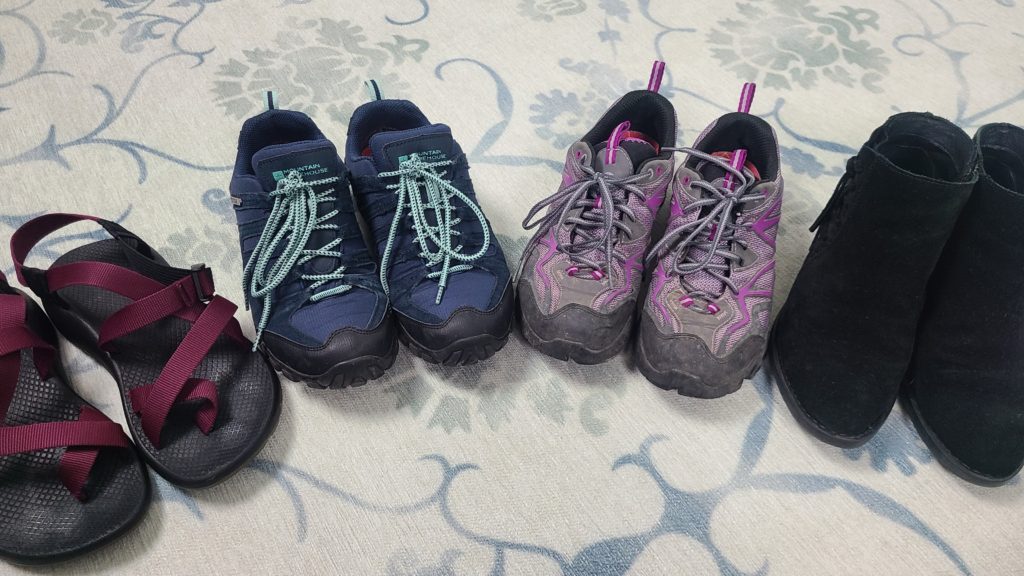Okay, let’s talk about packing. Yes, yes, we’ve touched on this before, but haven’t talked about it directly, so let’s do that now. But first, a question: Which is worse – packing or unpacking? We’re a divided house when it comes to this. Tasha hates packing with a passion…too many things she wants to take and SUCH limited space (more on this, below)! Not surprisingly, Jason has a slightly different take on this. When packing, you at least have something to look forward to (your trip, duh). When you’re unpacking, that usually means you’re back home and back to your normal grind. Meh. What say you?

With that important question out of the way, let’s talk about packing, or at least how we do it. But first, our current scenario. For the first time in more than two years, we’re finally planning our next sojourn back to Scotland! Super pumped! As of now, the plan is to be across the pond for a little over two weeks, exploring the Outer Hebridean islands, one of the places we’ve yet to see, and the Highlands, again, because they’re amazing. And no trip to Scotland is complete without a day or two in Edinburgh taking in the Royal Mile and Old Town. The catch: as is our norm, we’re planning to do this with no more than a carry-on and backpack each. When we tell people this, we get lots of confused looks: but how do you pack enough for weeks in such a small space?
When we pack for long(er) trips using only carry-ons, we tend to follow four simple rules:
1. Natural Fibers. I know, I know…we’ve mentioned this before. Still, we think it’s important enough to mention again. Before we started travelling more (of course, before the pandemic), we used to pack our regular clothes. You have them, why not use them? Trouble is, most clothes with synthetic fibers can really only be worn once before they stink and they take up an awful lot of space in our bags. That meant we needed larger bags to take with us, which is always a pain, not to mention incur checked baggage fees with your airline. What we’ve discovered is packing natural fibers makes life easier.
Let’s clarify what we mean by natural fibers. For us, this means wool, specifically Merino wool. Cotton is also a natural fiber, as is linen, flax, hemp and things of that nature; however, we’ve found that cotton and linen turn into terrible wrinkled messes in your suitcase and honestly, stink quickly despite their breathe-ability. If it’s really good quality, linen can often take care of itself when you take it out and hang it up, but that’s not always the case with cotton, as it’s a heavier fiber and so takes more coaxing to look good. However, we don’t have any of these issues with wool, as we’ve noted below.

What we like. We have two main brands of wool clothing we like to take when we travel. Tasha swears by Woolx (psst: our link gets you $20 off when you sign up with your email); Jason likes this, too, but has also recently discovered Paka, which uses alpaca wool (blends) for their clothes. Both have largely the same benefits, so let’s talk about those.
First, let’s squash the misconception that wool is itchy. Not all wool is created equally. Merino, Alpaca and Cashmere wool is incredibly soft and comfortable, whereas most sheep, lamb, and recycled wools can be various degrees of itchy, albeit, warm and damp wicking. They make great outer layers but you may not want them right up against your skin.
Second, wool can be thin while not sacrificing its ability to keep us warm. Thin means they take up less space in our suitcase so we can pack a few more options (Tasha) or leave empty space for Scotch at the Duty Free shop (Jason). There are various weights of Merino wool that allow you to wear it in all seasons. Tasha has light weight tanks and tees for summers in the desert that allow you to sweat but quickly wicks it away to dry quickly and heavy weight leggings, long sleeve tops and sweaters to wear in the mountain winters with a tight weave to hold heat in. She swears by wool underwear all year round (so weird) and we both love wool socks in all seasons to keep our feet dry, warm or cool and from stinking.
Third, yes, it looks wrinkly as we’re unpacking, but hang them up for a few minutes and you can basically watch the wrinkles fall out. We usually hang things we want to wear the next day at night and by morning they look perfect. Need to speed it up? Hang it in the bathroom while you take a shower and let the steam do the work for you.
Fourth, wool is porous. It has these tiny air pockets that allows your skin to breathe and the fabric to allow more airflow to dry it out faster. On the flip side, these pockets can also hold your body heat keeping you cozy warm in colder temps. It has this nifty ability to both hold humidity and dry itself out all while not stinking because of its anti-microbial properties that keep bacteria from binding to the fibers. And! If you’re prone to spilling liquids every time you get a drink (ahem, Tasha), they just bead up and slide right off. No red wine stains here! Nature is so cool. Ok, done nerding out.
Fifth, we’re able to wear each item multiple times before having to wash it. That, in turn, means we can either pack less clothing or the same amount, but it’ll last us longer. If we do have to wash it, it’s remarkably easy to wash at night in the sink with detergent sheets and be dry and ready to wear the next morning.
And finally, wool is renewable. It comes from sheep, goats, alpacas, and llamas and they need a haircut multiple times a year. They’ll actually thank you for it. Wool can also be recycled and won’t catch fire and melt to your skin like synthetics. You know those warnings on certain fabrics that say not to make sleepwear out of it (maybe you only know this if you sew)? That’s because of the plastic in synthetic fibers. If it catches fire while you are unaware in the night, the risk of burns and death from it melting to your skin is so much higher.
Thanks for coming to my TED talk.
What we don’t like. This list is short. Really short. In fact, there’s only one thing to mention here. If you’re going for good quality, well-made, natural fibers, you’re going to end up spending more on your clothes. Maybe a lot more. Let’s honest, the stuff we buy from Woolx and Paka is neither cheap nor inexpensive, so be prepared for a little price shock the first time you go looking. At the same time, we think it’s worth it so are okay making the investment. That does mean we don’t buy tons of stuff at once and we’re always looking for sales on their websites to soften the blow. Still, expect clothes like this to set you back a bit more than what you’ll find elsewhere. On the plus side, if you follow the care instructions, it will last a very long time. Tasha has pieces she’s been wearing nearly every day for at least 5 years and counting.

2. Packable makes it possible. This is something that sounds obvious, but we didn’t really think much about it until recently. Here’s the thing: we like to spend most of our travelling time in Europe and the Western US, and we try to go in shoulder season, or during low season. Shoulder season is typically in Spring or Fall right before and after high/busy season. Low season is typically in the winter in the Northern Hemisphere. That usually means the weather is a bit cooler and more damp than during peak tourism times. We’re okay with that, but it means we need layers (see above comment about natural fibers, which are great for layering) and a jacket that’ll keep us warm. Trouble is, warm jackets are often bulky. Often, but not always. Over the last few years we’ve really come to appreciate the packable outerwear from places like LL Bean. These are normal sized/looking jackets, with the latest technology to keep you warm, but they pack down into one of their interior pockets, which means a full-size jacket will pack down to about the size of a men’s size 10 shoe or even smaller. Amazing, right? Jason also likes a packable vest, which is great at maintaining body temperature and packs down even smaller. In fact, he usually clips the packed-down vest to the outside of his backpack, just so it doesn’t take up space elsewhere and he can grab it easily when it gets chilly on the plane.

3. Wash ‘em. Probably more than anything else that helps us be gone for a semi-extended period of time and not take our entire closets with us is the ability to do laundry while gone. Admittedly, this isn’t something we really thought about until recently, but it’s been a game-changer. What we’ve found is there are really two good ways to do your laundry while travelling.
First, many of the major hotel chains have laundry facilities or services you can use. We find that most B&Bs we stay at don’t have this option, but that just means every now and again when we’re near a larger city/town, we look for a more familiar brand for a night or two so we can do our laundry. If you’re staying somewhere that doesn’t explicitly mention this as an option, ask the front desk. At least once we’ve had the hotel agree to do a load of laundry for us (which was actually about 13 loads while leading study away with students). To clarify, this means they put everything in the same load, probably IN your laundry bag and your clothes may or may not be folded when you get them back. But, they’re clean, and that’s not nothing.
Second, if there really aren’t laundry options around you, you can do it yourself in your hotel room. We used to drop into the druggist (we call them pharmacies in the US) or grocery store to get a small tube of detergent that’s specifically designed to use in your bathroom sink. More recently Tasha found sheets (they look like dryer sheets) that are laundry detergent. We like these better because they’re dry, not liquid. That scores two points: one for being lighter and easier to pack, and a second because if you get them in the US, they don’t concern the TSA folks or count against your liquids allowance. With the necessary supplies in-hand, the rest is pretty familiar. Fill the sink with hot water (or cold, depending on what you’re washing), add the detergent and your clothes. Rub them around a bit, let soak as long as you like, then rinse, hang-up, and repeat. Fun fact: lots of bathrooms around Europe have heated towel racks that work really well at drying your clothes, and faster than you might expect. Also, if you’ve packed natural fibers, they’ll dry super fast on their own and you can leave the heated rack for anything synthetic you’ve brought along. Pack your stuff back into your bags and you’re ready for the next leg of your trip, smelling fresh!
4. Color Families and Restyling. Trust me, I know Instagram has put in your head that you need 800 outfits, one for each stunning beach or mountain top pose, and shoes, jewelry, a fun hat and styling products to get the look. Let me just stop you there and take a minute to think about how big your suitcase(s) is going to have to be to. Yikes. When Tasha started traveling at 20 years old, this is how she traveled. Her very first trip, she showed up in Pennsylvania with the biggest suitcase she could find (stamped oversized by the airline), a full-size carryon and an enormous purse…for a week. Since then she’s done a ton of travel research, traveled a ton more, gotten countless eye rolls from overpacking and learned about color families and restyling.
Let’s start with color families. Pick a good neutral base color: black, navy, gray, brown, tan, white. Like any good early 2000s emo girl, Tasha started with classic black. It’s flattering, hides dirt, blends in, is classic and punk. Now ONLY pick things that will go with black (which is basically everything). Her favorites are purple, blue, green and currently, rose gold or diamond – jewel tones, cool colors. For a two week trip we typically pack about 3-4 days worth of clothes that can be mixed, layered, restyled and jewelry and shoes that can go with everything. ALWAYS take 2 pairs of shoes. You might destroy a pair or suddenly your favorite sandals might suddenly start to give you blisters. You don’t want to have those be your only option! Tasha lives in leggings at home (and studio, rehearsal, chores, store stocking, etc) and swears by leggings with pockets for planes. Leggings are not appropriate in all places so be sure to have a nice pair of pants (she loves yoga dress pants and skorts from Betabrand – our link gets you $15 off your first order) or a casual dress (black) for dinners out and jeans, hiking pants, a skort (almost never shorts) or even dress pants/stretchy chinos for daytime adventures. Pair with a wool top within your packed color family, basic jewelry and stuff a coordinating scarf/cardigan/wrap in your day bag. In the summer she will pack almost entirely dresses and a wrap to match them all. It’s super easy to just grab a dress for the day and not have to put an outfit together. Remember most places outside of the USA typically dress not as casual as we do at home. We’ll put together later posts on what to pack for each type of adventure we’ve been on. There are things we bring every time we pack a bag and things only appropriate for certain climates or cultures.

In the end, travelling is supposed to be about the adventure and exploring new areas, not lugging unnecessarily large suitcases upstairs when there’s no lift, along cobblestone streets, trying to cram them onto trains/planes or into cars trunks that are smaller than we’re used to. Over the years we’ve discovered plenty of ways that make this doable, but there are lots of other ways to make this happen, too. We’ve had a lot of trial and error but have definitely gotten to the point where we can pack trusty staples and not have to go on a shopping spree before every trip.
We didn’t even touch on toiletries. That’s another animal and another post. Stay tuned.
If you’ve discovered tips and tricks that make travelling easier for you, leave us a comment explaining what you do!




